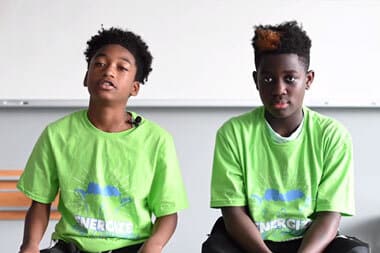 Hispanic and Latinx Heritage Month & Working with Latinx Students and Families
Hispanic and Latinx Heritage Month & Working with Latinx Students and FamiliesBy: Connor Kirkpatrick and Andrea Rodriguez
Welcome to the Youth Work 101 Series! Student U uses this blog series to support youth work practitioners, educators, advocates for young people, and after-school professionals in their work by sharing what has worked for us and by offering free resources each month on a best practice. Click here for this month’s resource for youth workers.
This month’s blog on Hispanic Heritage Month & Working with Latinx Students and Families is paraphrased from an interview with Andrea Rodriguez, Student U’s Bilingual Families Advocate, with writing by Connor Kirkpatrick, Student U’s Development Associate.
¡Hola, y feliz Mes de la Herencia Latinx y Hispana! Hello and happy Latinx and Hispanic Heritage Month!
Every year, from September 15 to October 15, the U.S. recognizes and celebrates the culture and contributions of Latinx Americans to our country. These weeks also mark the days in which many Latin American countries gained their independence from the countries they were colonized by (mostly Spain):
-
- September 15 marks the anniversary of independence for Costa Rica, El Salvador, Guatemala, Honduras, and Nicaragua who declared independence in 1821.
- September 16 marks the anniversary of Mexico’s independence.
- September 18 marks the anniversary of Chile’s independence.
- September 21 marks the anniversary of Belize’s independence.
This month is a celebratory time for autonomy and freedom, and for those of us that live in the United States, this is an important time to connect with the cultures of our motherlands. Typically, there’s a lot of food, dancing, and fun events (pre-COVID times). Hispanic Heritage Month is also a bit like being an American in Canada and celebrating the fourth of July with a small group of Americans — it’s definitely not as large as celebrating in your home country, but it’s still a great time and you celebrate sharing a common love for your country.
As educators, Hispanic Heritage Month is also an excellent opportunity to learn more about your Latinx students and celebrate the diverse backgrounds that they come from! This starts with listening, and cultivating the safe spaces in your classrooms, and facilitating activities that encourage students to share where they are from. At Student U, we have students with families from Mexico, Honduras, El Salvador, Guatemala, and a host of other Latin American countries that we will only know when we find the time and space to ask our students about it. Allowing students to share this piece of themselves allows them to feel seen, heard, and valued.
A Note on Terminology:There are several terms to refer to Latinx students and families. Student U uses the term ‘Latinx’ generally to describe Latin American students and families, but this term has its own flaws. Ultimately, there is no one right term and there is disagreement about what is the most appropriate term to use. Here is a quick glossary of some of these identity markers:
-
- Hispanic is a term that derives from the Latin word ‘Hispanicus’ and refers to Spain and the Iberian Peninsula in Europe. This term refers to people, communities, and cultures connected to the Spanish language, Spanish culture, Spanish people, or to Spain in general. Critics of this term say it centers Spain’s colonialism.
- Latinx or Latine is a gender-neutral term that is used instead of Latino, Latina, and Latin@ that refers to people of Latin American cultural or ethnic identity. This term is very recent and is more popularized in academic settings, and only 3% of Latino adults use this term. Some critique this term as being difficult to pronounce in Spanish and not being used in Spanish-speaking countries at all, so this term may not be the best term to use with families with Latin American heritage since it may be alienating. However, this term is inclusive of people of all gender identities and is useful for LGBTQ+ identifying Latin Americans who wish to avoid the gender binary that is frequently utilized in the Spanish language.
- Chicano, Chicana, or Chicanx is an identity that describes people of Mexican descent born in the US. This identity is also associated with the social and political movement to combat structural racism and reject assimilation in the 60s and 70s.
- Spanish-Speaking refers to people who speak Spanish. While useful in its generality, it does not describe a country of origin or ethnic identity. Additionally, ESL stands for ‘English as a Second or Foreign Language’ describes students in school who learn to speak English with a different native language.
- Many Latinx people also prefer country of origin labels (such as Mexican or Cuban or Ecuadorian) to pan-ethnic terms such as Latinx or Hispanic. In a study done by the Pew Center in 2015, 50% of Hispanics described themselves most often by their country of origin/heritage, while 23% used the term Hispanic/Latino, and 23% identified as American.
Because there is no one term, it is important to allow students space to use the identity label that most resonates with them. Doing an activity such as having students write a poem about where they are from can facilitate students discovering the words to describe themselves and their ethnic heritage.

 Working with Latinx Students and Families
Working with Latinx Students and FamiliesWhen working with Latinx Students and Families, it is so important to first listen to their experiences and affirm their rich identities, as mentioned above. It is also important to communicate with families in the language they are most comfortable in if you can. This means becoming proficient in Spanish, or practicing what you already know! Speaking in Spanish is such an important skill that will help you build better relationships with Latinx families. Here are some ways you can improve you’re spanish and work better with Latinx students and families:
-
- If you are a beginner, seek out local classes in Spanish, or even start with Duolingo.com, a great resource for beginners who want to get a grounding in Spanish. El Centro Hispano also offers Spanish as a Second Language class.
- Spend time reading and watching books, movies, and TV shows in Spanish. Choose texts for your class that center the Latinx experience. Here is a great list of books to get you going.
- Allow and encourage students to write and speak in Spanish in your classroom if it makes them more comfortable. This will improve your fluency AND allow students to communicate in their most comfortable way.
- Use Google Translate to write text messages and communicate through writing with families if you feel uncomfortable speaking. It can be a good idea to have a Spanish-speaker review your message before sending, especially if your message contains unique academic words.
- Practice, practice, practice. If Spanish is not your first language, speaking it can feel intimidating. What is important is to start. The only way to gain proficiency is to try. Gather friends and colleagues to start a spanish conversation hour to practice your fluency. Student U has a weekly ‘Spanish Lunch’ where people from varying levels of Spanish fluency can come and talk. This can be as casual or structured as the group wants to be, with the goal of simply practicing your Spanish!
- If you are Bilingual in Spanish and are interested in learning more about supporting Latinx students, see if your community has a Latino Parent & Family Advocacy and Support Training (LPFAST) and attend!
This month, we are offering our Spanish Toolkit as a resource. This document contains call and text scripts to help you better communicate with spanish-speaking families, as well as has a word bank of common academic words and their spanish variants. Click here to download Student U’s Spanish Toolkit.
We hope that this post and resource is useful for you in thinking about how to best support your own Latinx students that you may be teaching virtually this year. Finally, if you are interested in Latinx political organizing (the election is quickly approaching!) Mijente is an excellent organization that has resources and opportunities to engage with.
See you in the next post. ¡Adios!
—
Donate to Student U and keep posts like this one coming.
Subscribe to this blog by entering your email to download the resource above.









